question id: buck-shut-stove-1
Chap 8 Exercises
\[ \newcommand{\dnorm}{\text{dnorm}} \newcommand{\pnorm}{\text{pnorm}} \newcommand{\recip}{\text{recip}} \]
Exercise 1 Figure 1 shows the proportion \(P\) of the US cell-phone users who own a smart phone as a function of the year \(y\).

As a rule, when a quantity grows exponentially but is ultimately limited to some maximum level, the sigmoid is the choice for modeling. The proportion of smartphone owners grew exponentially during the early 2000’s. As the number of smartphones increased, the broader familiarity with smartphone advertisements also increased, which helped sustain this exponential growth. However, adoption has slowed as smartphone penetration reaches the maximum carrying capacity. In other words, once everyone has a smartphone, the proportion of smartphone owners cannot increase—everyone already owns a smartphone. So, eventually the exponential growth must taper-off. According to several datasets, this inflection point occurred sometime between 2013 and 2014. This behavior is visible in the graphic below showing US smartphone penetration between Jan 2005 and Oct 2020 with raw data shown from 2010 to 2015.
- During the initial, exponential phase of smartphone penetration, what was the doubling time for penetration? Use 5% penetration as the reference level. (Note that the horizontal axis labels have 1/4 year inbetween them.) Pick the closest answer.
- Referring to the black sigmoid curve, what is the mean parameter? Pick the closest answer.
question id: buck-shut-stove-2
- Referring to the black sigmoid curve, what is the standard deviation parameter?
question id: buck-shut-stove-3
Credit: 2021-2022 Math141Z/Math142Z development team.
Exercise 2 Each of the following plots shows a basic modeling function whose input scaling has the form \(x - x_0\). Your job is to figure out from the graph what is the numerical value of \(x_0\). (Hint: For simplicity, \(x_0\) in the questions will always be an integer.)

- In plot (A), what is \(x_0\)?
question id: fp-dnorm

- In plot (B), what is \(x_0\)?
question id: fp-sin

- In plot (C), what is \(x_0\)?
question id: fp-log

- In plot (D), what is \(x_0\)?
question id: fp-pnorm

- In plot (E), what is \(x_0\)?
question id: fp-recip
Exercise 3 Each of the graphs shows two horizontal scales, one drawn on the edge graphics frame (black) and one drawn slighly above that (blue). Which horizontal scale (black or blue) corresponds to the pattern-book function shown in the graph?

For graph (A), which scale corresponds to the pattern-book function?
question id: siD-A

For graph (B), which scale corresponds to the pattern-book function?
question id: siD-B

For graph (C), which scale corresponds to the pattern-book function?
question id: siD-C
Exercise 4 Find the straight-line function that will give the value on the bottom (black) scale for each point \(x\) on the top (blue) scale. The function will take the top(blue)-scale reading as input and produce the bottom(black)-scale reading as output, that is: \[\text{black}(x) \equiv a (x - x_0)\]

- For Graph A, which function maps blue \(x\) to the value on the black scale?
question id: scale-input-2-A

- For Graph B, which function maps blue \(x\) to the value on the black scale?
question id: scale-input-2-B

- For Graph C, which function maps blue \(x\) to the value on the black scale?
question id: scale-input-2-C

- For Graph D, which function maps blue \(x\) to the value on the black scale?
question id: scale-input-2-D
Exercise 5 The gaussian function is implemented in R with dnorm(x, mean, sd). The input called mean corresponds to the center of the bump. The input called sd gives the width of the bump.
- Active R chunk 1 makes a slice plot of
dnorm(x, mean=0, sd=1). By running the chunk several times while experimentally varying the value ofsd, figure out how you could estimate that value directly from the graph.
In Figure 2, one of the double-headed arrows represents the sd parameter. The other arrows are misleading.

- Which arrow shows correctly the
widthparameter of the gaussian function in Figure 2?
question id: hump-intro-2
- What is the value of
centerin Figure 2?
question id: hump-intro-3
Exercise 6 The distribution of adult heights is approximately Gaussian. The graph below shows the distribution of adult males and females separately. Use this graphic to answer the following questions.
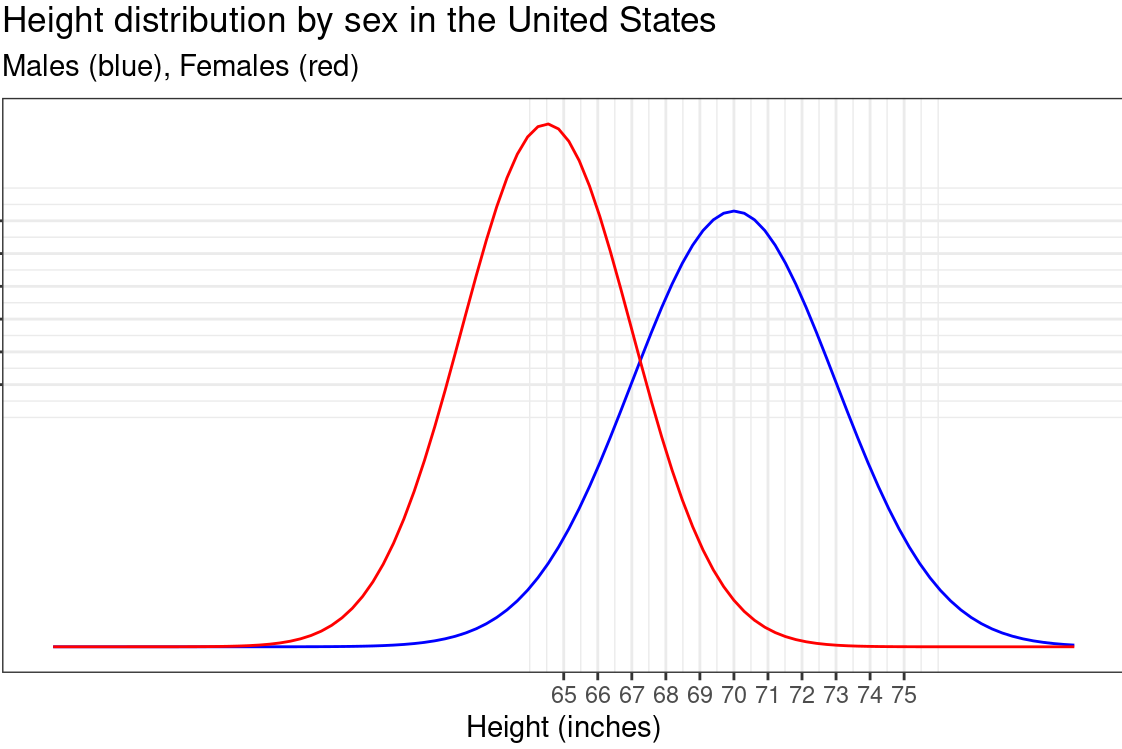
- Which sex has a larger mean height?
question id: squirrel-toss-glasses-1
An important fact about the gaussian function is that the area under the graph is always 1. This means that, when comparing two gaussians, the taller one will be the narrower one.
- Which sex has a larger standard deviation of height?
question id: squirrel-toss-glasses-2
The standard deviation of a gaussian can be estimated visually based on its graph. Let’s estimate the standard deviation for males. To do this, start at the peak of the male distribution. The output value at the peak is \(0.1329\). Find the output value that is 60% of this peak value. We’re looking for the value \[0.1329(0.6)=0.0797\approx0.08\] on the output (vertical) axis. Now, measure the half the width (i.e. along the horizontal axis) of the Gaussian along the line \[y=0.08\]. This is the standard deviation.
- Which of these is the best estimate of the standard deviation of the distribution of heights for males?
question id: squirrel-toss-glasses-3
- The female height distribution has a mean of 64.5 and standard deviation of 2.5. Which R command can we use to plot the Gaussian for females?
slice_plot(dnorm(x,64.5,2.5)~x, domain(x=0:64.5)
slice_plot(dnorm(x,64.5,2.5)~x, domain(x=50:80)
slice_plot(pnorm(x,64.5, 2.5)~x, domain(x=0:64.5))
pnorm(x,64.5,2.5)~x
question id: squirrel-toss-glasses-4
Credit: 2021-2022 Math 141Z development team
Exercise 7 The Wikipedia entry on “Common Misconceptions” used to contain this item:
Some cooks believe that food items cooked with wine or liquor will be non-alcoholic, because alcohol’s low boiling point causes it to evaporate quickly when heated. However, a study found that some of the alcohol remains: 25% after 1 hour of baking or simmering, and 10% after 2 hours.
The modeler’s go-to function type for events like the evaporation of alcohol is exponential: The amount of alcohol that evaporates in one hour would, under constant conditions (e.g. an oven’s heat), be proportional to the amount of alcohol present at the beginning of the hour.
- Assume that 25% of the alcohol remains after 1 hour? If the process were exponential, how much would remain after 2 hours?
question id: cow-type-kayak-1
- What is the half-life of an exponential process that decays to 25% after one hour?
question id: cow-type-kayak-2
Let’s change pace and think about the “10% after 2 hours” observation. First, recall that the amount left after \(n\) halvings is \(\text{amount.left}(n) \equiv \left(\frac{1}{2}\right)^{\Large n}\) This is an exponential function with base 1/2.
You’re going to carry out a guess-and-check procedure to find \(n\) that gives \(\text{amount.left}(n) = 0.10\).
Active R chunk 2 includes the definition of the amount.left() function. We start with a guess of \(n=10\), which is wrong. Change the guess until you get the output 10%.
- Use
amount.left()as defined in the scaffolding to guess-and-check how many halvings it takes to bring something down to 10% of the original amount.
question id: cow-type-kayak-3
- The answer you got in part C) is the number of halvings needed to reach 10%. If this number occurs in 2 hours (that is, 120 minutes), what is the half life stated in minutes.
question id: cow-type-kayak-4
Exercise 8 The graph shows the cumulative number of Ebola cases in Sierra Leone during an outbreak from May 1, 2014 (Day 0) to December 16, 2015. (Source: {MMAC} R package, Joel Kilty and Alex McAllister, Mathematical Modeling and Applied Calculus.) Put aside for the moment that the Ebola data don’t have the exact shape of a sigmoid function, and follow the fitting procedure as best you can.
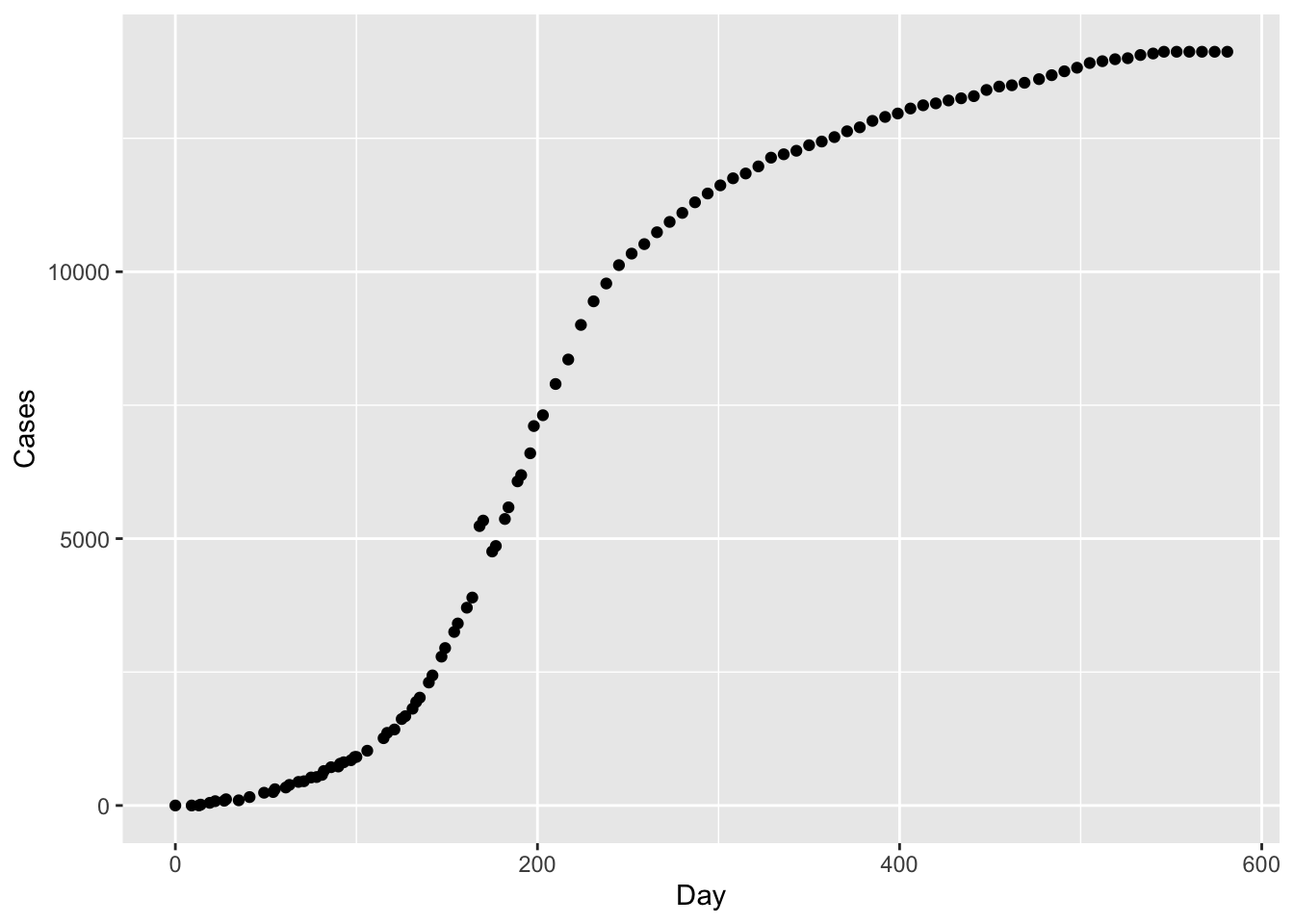
- What is the the value of the function at the top plateau?
question id: ebola-sigmoid-1
- On what day did the number of cases reach half-way to its eventual plateau?
question id: ebola-sigmoid-2
- Now to find the “standard deviation” parameter, that is, the standard way for describing the width of the sigmoid. The curve looks more classically sigmoid to the left of the centerline than to the right, so follow the curve downward to find the parameters. What’s a good estimate for
width?
For a gaussian function, you know how to find the standard deviation. But we are dealing with a sigmoid here. Lets put the algorithms for finding the standard deviation side by side to guide you.
| Step # | parameter | Gaussian | Sigmoid |
|---|---|---|---|
| 1 | center (or “mean”) | Find the input corresponding to the peak of the curve | Find the input where the value of the curve is 1/2 the value of the plateau. |
| 2 | Find the level of the output that is 60% of the height of the peak. | Find the level of the output that is 60% of the way to the value at the center. | |
| 3 | standard deviation | The difference in input between (1) and (2). | The difference in input between (1) and (2). |
question id: ebola-sigmoid-3
Exercise 9 Each of the curves in the graph is an exponential function \(e^{kt}\), for various values of the parameter \(k\).
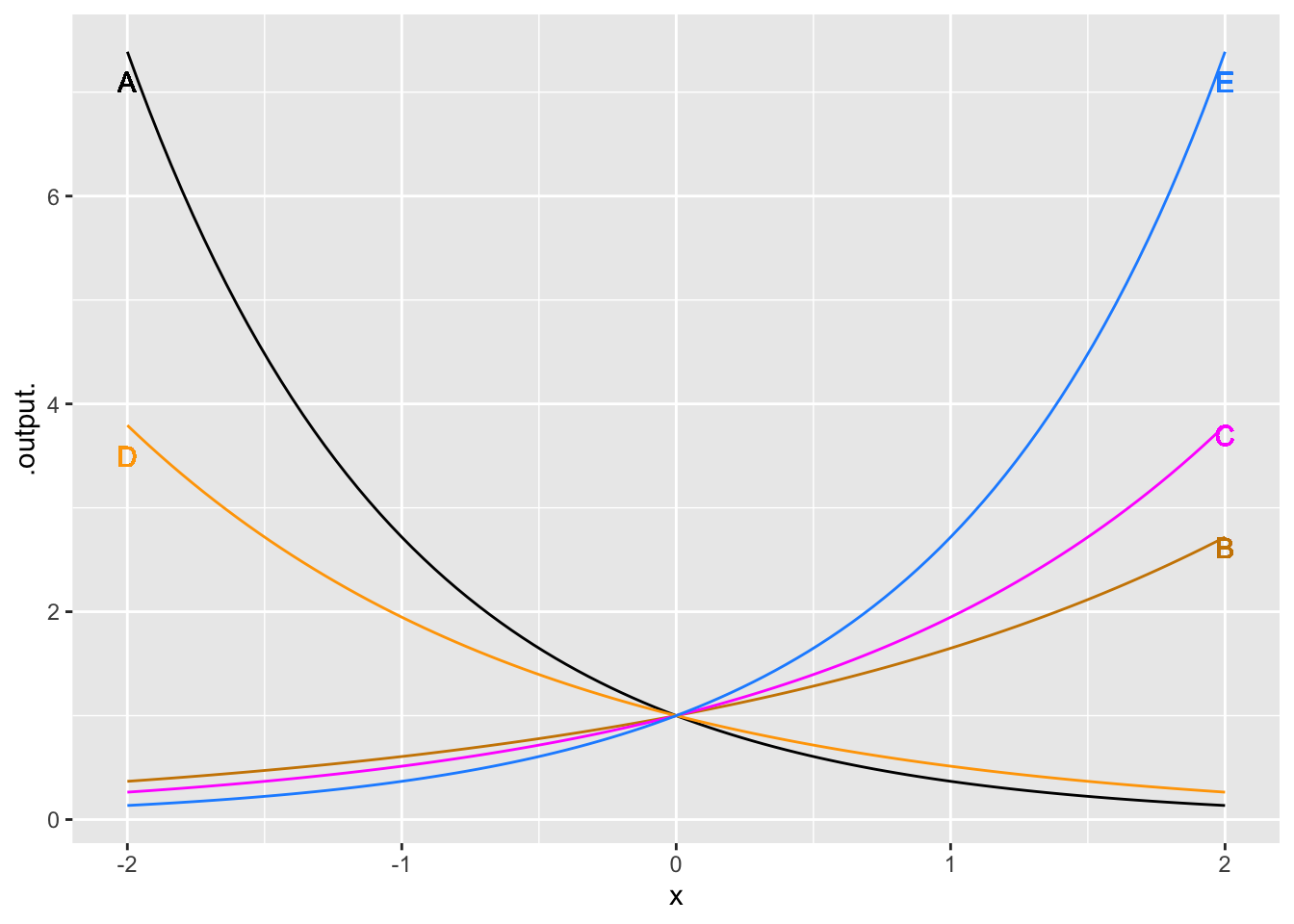
What is the order from \(k\) smallest (most negative) to k largest?
A, D, B, C, E
A, B, E, C, D
E, C, D, B, A
question id: WkG3cD
Exercise 10 The three functions defined in Active R chunk 3 are different in how they handle the period of the sinusoid.
- Which two functions will produce output when only a single input, such as
(3)is used?
f1() and f2() f1() and f3() f2() and f3()
question id: snake-teach-screen-1
- Which two functions will accept a second argument such as
P=10?
f1() and f2() f1() and f3() f2() and f3()
question id: snake-teach-screen-2
- Which function will work in both (1) and (2)?
f1() f1() f3()
question id: snake-teach-screen-3
- Which of these best describes the meaning of
P = 6in the second argument tomakeFun()?
It establishes the name of the parameter to the function.
It sets a default value for the parameter P.
It sets the default output when t = 0.
question id: snake-teach-screen-4
Exercise 11 The performance \(p\) of a worker depends on the level of stimulation/stress \(s\) imposed by the task. This phenomenon has come to be known as the Yerkes-Dodson Stress Performance Curve, and you’ve probably experienced this yourself. If a task is not stimulating enough people become inactive/bored and performance is negatively impacted. If tasks are over stimulating (stressful), people become anxious and fatigued; they burn-out. The overall Yerkes-Dodson pattern is shown by the diagram.
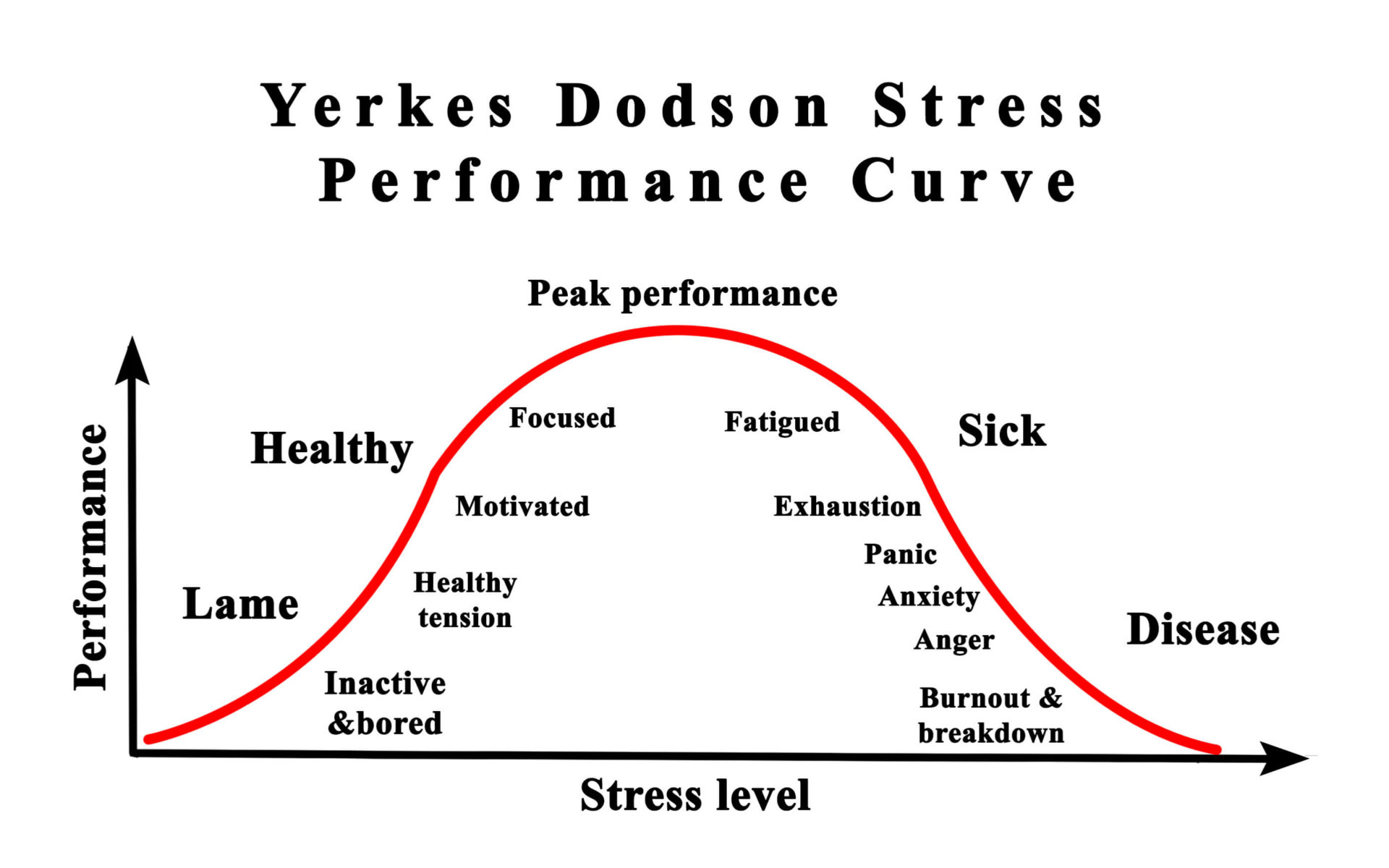
- Which of these functional forms best imitates the Yerkes-Dodson stress performance curve?
Proportional: \(p(s) \equiv as+b\)
Power-law: \(p(s) \equiv As^p\)
Exponential \(p(s) \equiv Ae^{kt}+C\)
Sine: \(p(s) \equiv A\sin\left(\frac{2\pi}{p}(t-t_0)\right)+B\)
Sigmoid \(p(s) \equiv A\cdot \pnorm(s,mean,sd)+B\)
Gaussian \(p(s) \equiv A\cdot \dnorm(s,mean,sd)+B\)
question id: horse-hold-mattress-1
A manager must balance workloads between too much and too little stimulation to get peak performance out of each team member.
- Does Figure 4 suggest that people inevitably burn out as time elapses?
question id: horse-hold-mattress-2
Exercise 12 These three expressions
\[e^{kt}\ \ \ \ \ 10^{t/d} \ \ \ \ \ 2^{t/4}\]
produce the same value if \(k\) and \(d\) have corresponding numerical values.
Active R chunk 4 contains an expression for plotting out \(2^{t/h}\) for \(-4 \leq t \leq 12\) where \(h = 4\). It also plots out \(e^{kt}\) and \(10^{t/d}\)
Your task is to modify the values of d and k such that all three curves lie on top of one another. (Leave h at the value 4.) You can find the appropriate values of d and k to accomplish this by any means you like, say, by using the algebra of exponents or by using trial and error. (Trial and error is a perfectly valid strategy regardless of what your high-school math teachers might have said about “guess and check.” The trick is to make each new guess systematically based on your previous ones and observation of how those previous ones performed.)
After you have found values of k and d that are suited to the task …
- What is the numerical value of your best estimate of
k?
question id: kid-type-boat-1
- What is the numerical value of your best estimate of
d?
question id: kid-type-boat-2
Exercise 13 The table shows eight of the pattern-book function shapes.
| identity | square | recip | gaussian |
|---|---|---|---|
 |
 |
 |
 |
 |
 |
 |
 |
| sigmoid | sinusoid | exp | ln |
- Identify which of the eight shapes will remain unaltered even when flipped left-to-right.
gaussian, logarithm, square
square, recip, sinusoid
sinusoid, gaussian, square
recip, sinusoid, exp
gaussian, proportional, recip
question id: lion-chew-bowl-1
- Identify which of the eight shapes will remain unaltered if flipped left-to-right followed by a top-to-bottom flip.
gaussian, logarithm, square, identity
square, reciprocal, sinusoid, identity
sinusoid, gaussian, square, identity
reciprocal, sinusoid, sigmoid, identity
gaussian, proportional, reciprocal
question id: lion-chew-bowl-2
- Identify which of the eight shapes will give the same result when flipped left-to-right or top-to-bottom (but not both!).
identity, logarithm, square, reciprocal
sigmoid, reciprocal, identity
sinusoid, gaussian, square
recip, sinusoid, logarithm
gaussian, proportional, sinusoid
question id: lion-chew-bowl-3
- Compare the doubly-flipped (first left-to-right then top-to-bottom) flipped exponential to the logarithm function. Is the doubly-flipped exponential equivalent to the logarithm? Explain your reasoning.
Exercise 14 Compare the functions \(f_1 \equiv \dnorm(x, mn, sd)\) and \(f_2 \equiv \dnorm\left(\left(x-mn\right)/sd\right)\) by plotting them out using Active R chunk 5.
To construct the plots, you will have to pick specific values for the parameters \(mn\) and \(sd\). Make sure that you use the same \(sd\) and \(mn\) when constructing \(f_1()\) and \(f_2()\). You should be able to select a plotting domain by reference to the To aid comparison, use the same graphics domain for both plots.
- When \(\text{sd} = 1\), are the two functions the same?
Yes
Yes, but only if \(\text{mn}=1\)
Yes, but only if \(\text{mn}=0\)
No
question id: dnorm8-1
- When \(\text{sd} \neq 1\), for any given mean, the two functions are not the same. What’s the relationship between \(f_1(x)\) and \(f_2(x)\)?
\(f_2(x) = sd\, f_1(x)\)
\(f_1(x) = sd\, f_2(x)\)
\(f_1(x) = sd^2 f_2(x)\)
\(f_2(x) = sd^2 f_1(x)\)
question id: dnorm8-2
Special topics
Exercise 15
Some of our pattern-book functions have a distinctive property called scale invariance. This means the graph of the function looks the same even when plotted on very different horizontal and vertical axes. The function \(\ln(x)\) plotted on two different scales in Figure 5 shows that the graph of the function has practically the same shape on either scale.
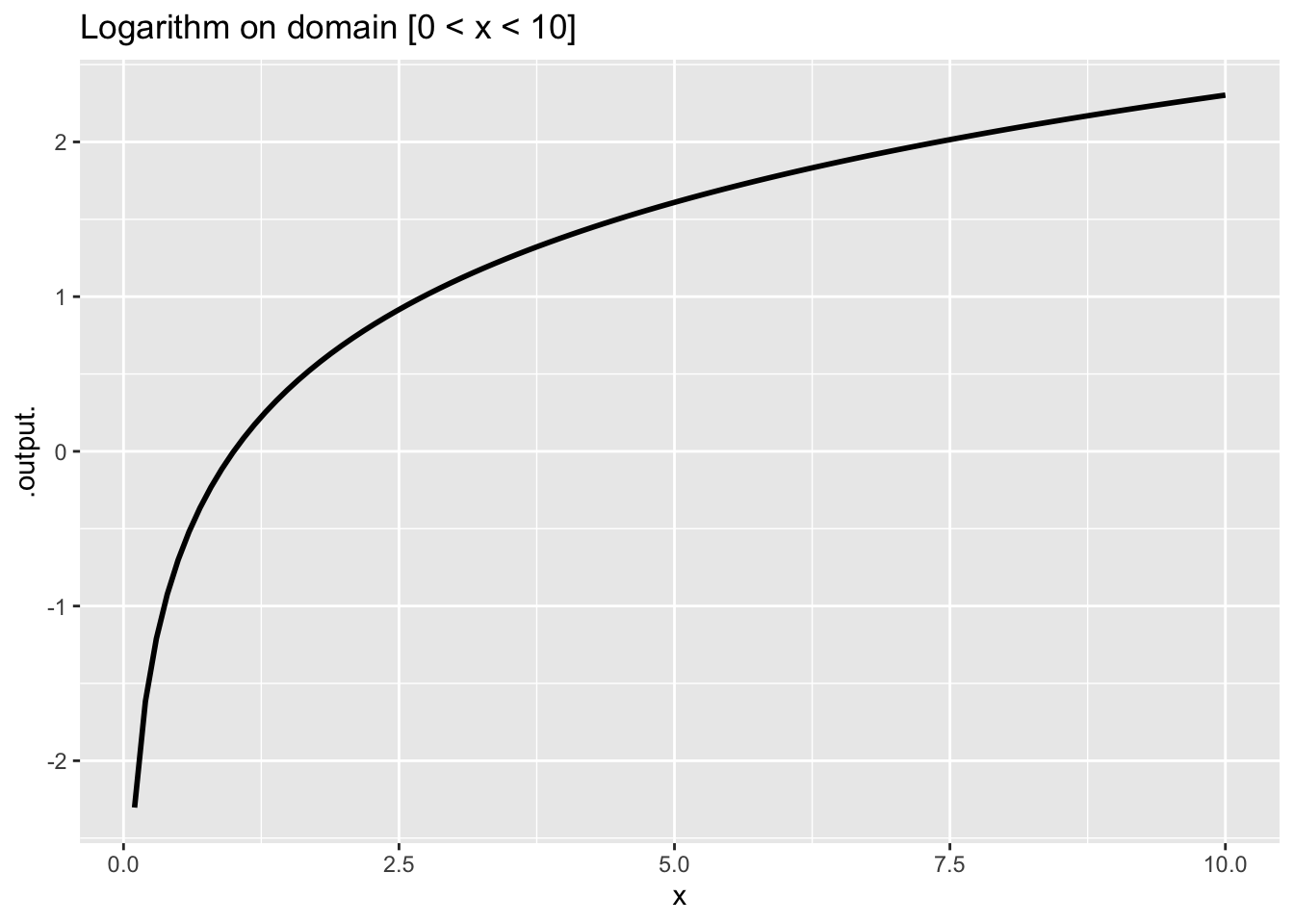
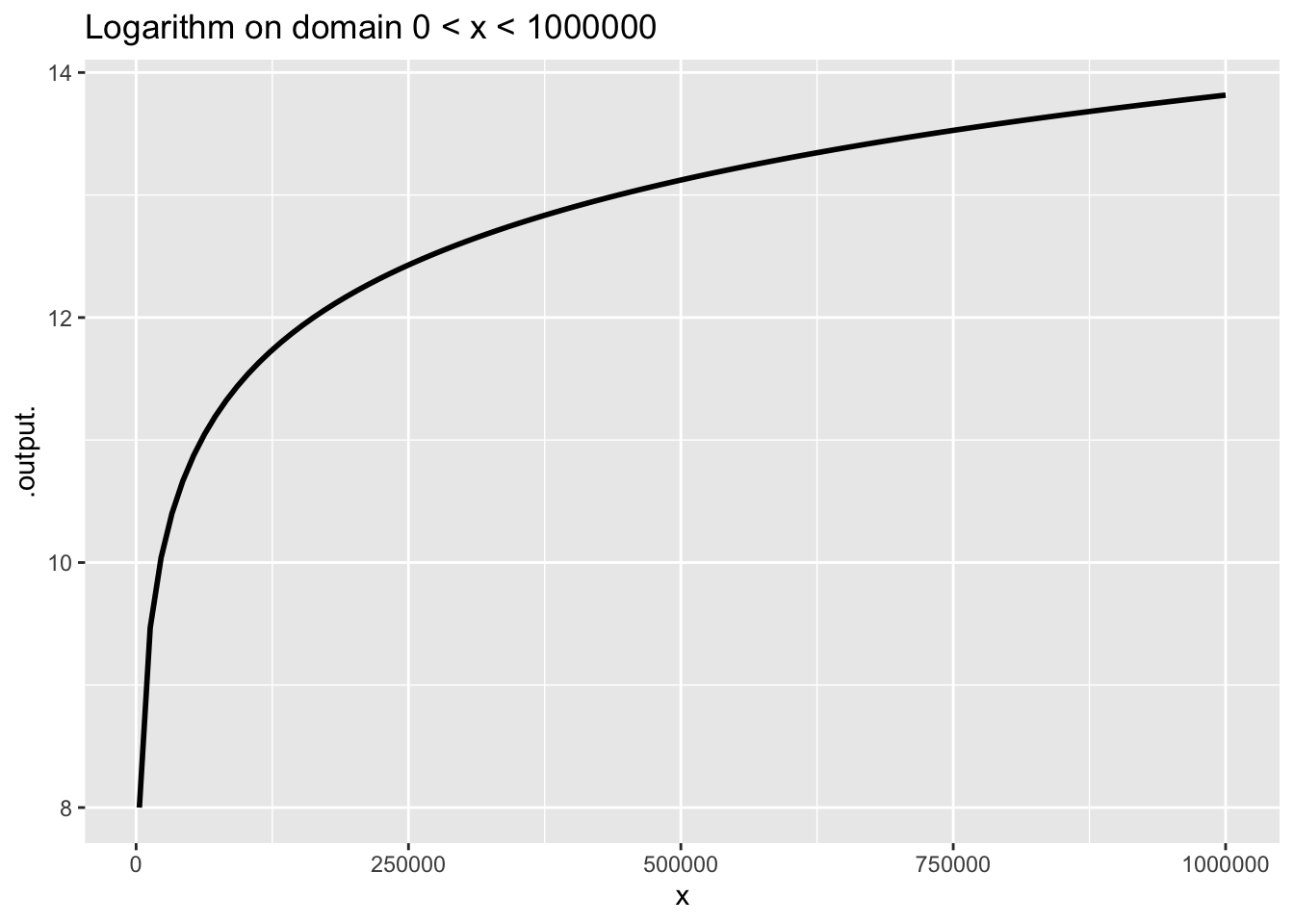
Figure 6 shows a power-law function, \(g(x) \equiv x^2\), which is also scale invariant.
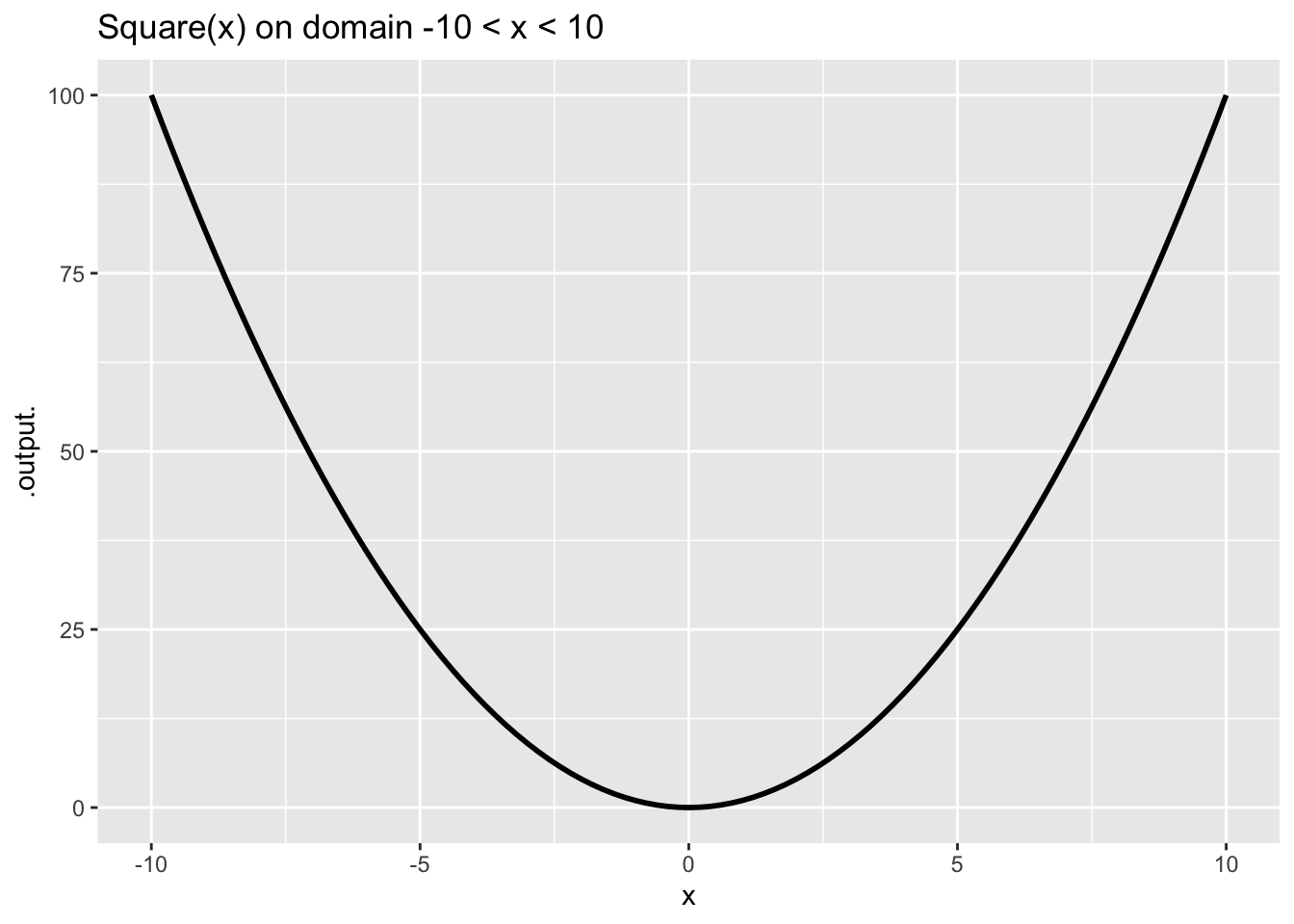
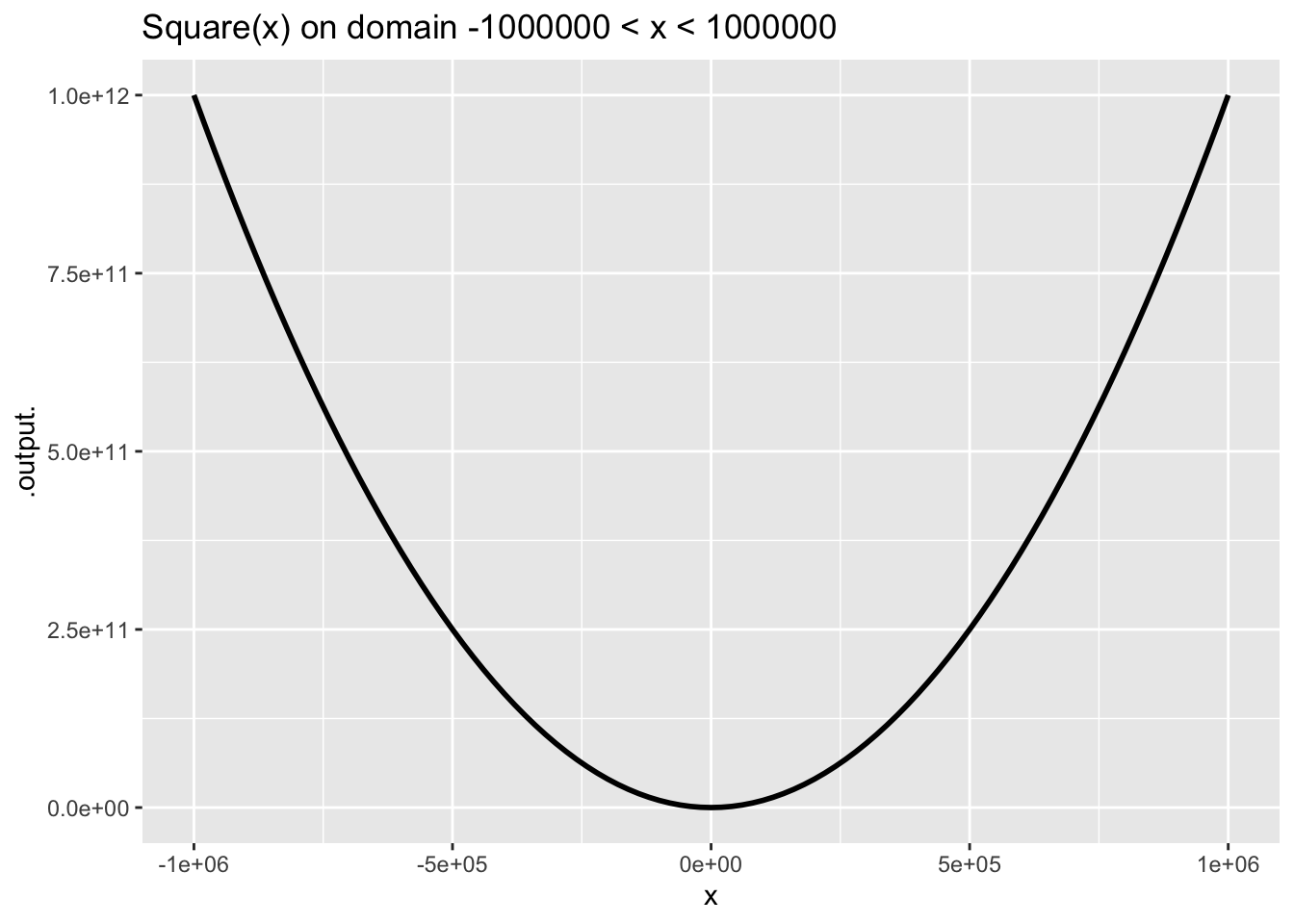
Other pattern-book functions are not scale invariant, for example \(\sin(x)\).
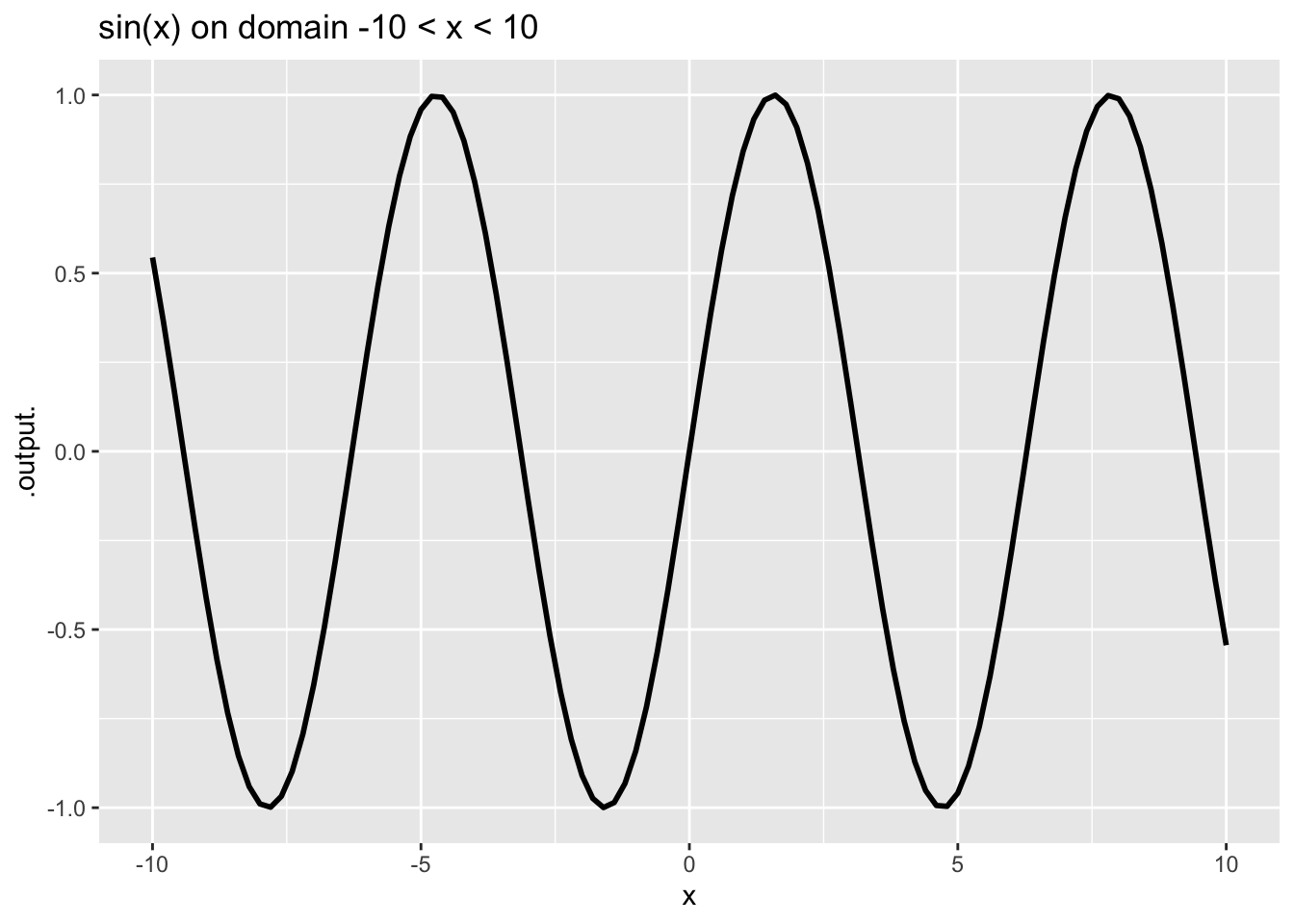
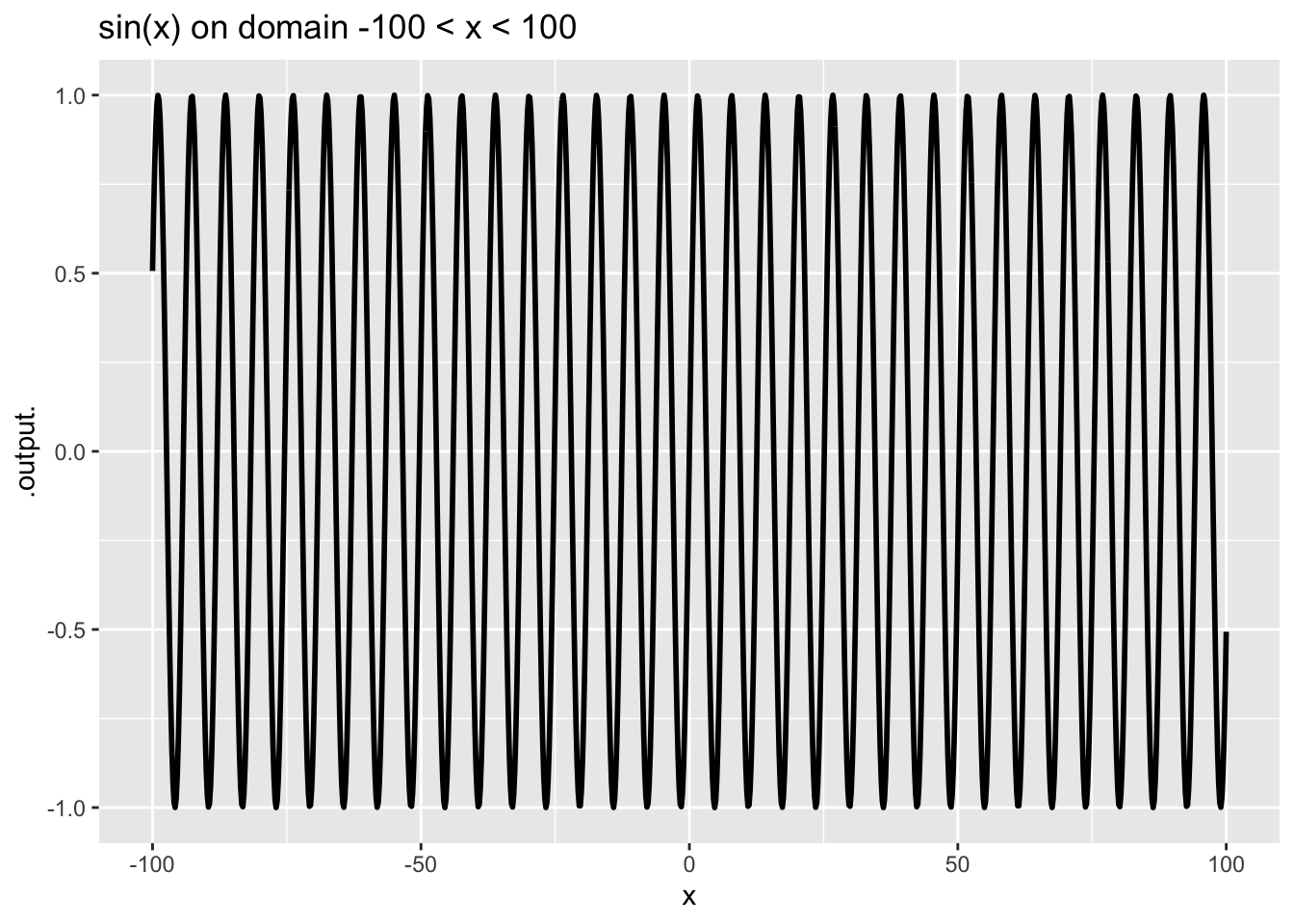
In contrast to scale-invariant functions, some of our pattern-book functions have a characteristic scale. This is a domain length over which the whole of a characteristic feature of the function is evident. Graphing on larger domains simply squashes down the characteristic feature to a small part of the graphic domain. For instance, in the \(\sin()\) function the cycle is a characteristic feature. The cycle in the pattern-book sinusoid has a characteristic length of \(2 \pi\), the length of the cycle. Consequently, the graph looks different depending on the length of the graphics domain in multiples of the characteristic length. You can see from Figure 7 that the graph on the domain \(-10 < x < 10\), that is, about 3 times the characteristic scale, looks different from the graph on the larger domain that has a length 30 times the characteristic scale.
The output of the sigmoid function runs from 0 to 1 but reaches these values only asymptotically, as \(x \rightarrow \pm \infty\). In defining a characteristic scale, it would be reasonable to look at the length of the domain that takes the output from, say, 0.01 to 0.99. In other words, we want the characteristic scale to be defined in a way that captures almost all the action in the output of the function. For a gaussian, a reasonable definition of a characteristic scale would be the length of domain where the output falls to about, say, 1% of its peak output.
- The gaussian (bump) function
dnorm()has a characteristic scale. Which of these is a domain length that can encompass the characteristic shape of the gaussian?
question id: bear-lay-plant-1
- The sigmoid function
pnorm()also has a characteristic scale. Which of these is a domain length that can encompass the characteristic shape of the sigmoid?
question id: bear-lay-plant-2
Throughout science, it is common to set a standard approach to defining a characteristic scale. For instance, the characteristic scale of an aircraft could be taken as the length of body. Gaussian and sigmoids are so common throughout science that there is a convention for defining the characteristic scale called the standard deviation. For the pattern book gaussian and sigmoid, the standard deviation is 1. That is much shorter than the domain that captures the bulk of action of the gaussian or sigmoid. For this reason, statisticians in practice use a characteristic scale of \(\pm 2\) or \(\pm 3\) standard deviations.